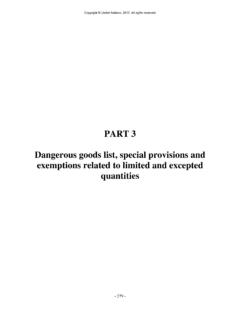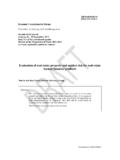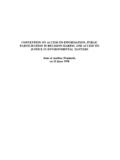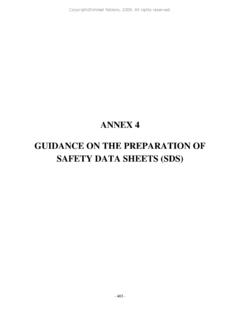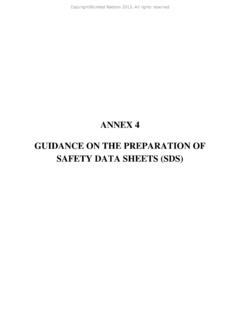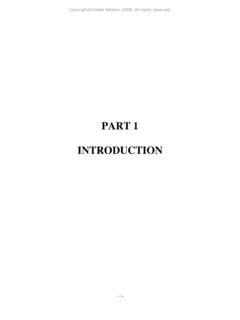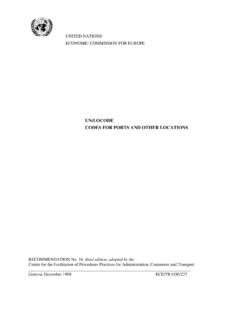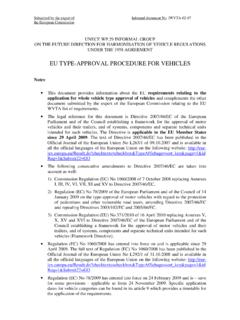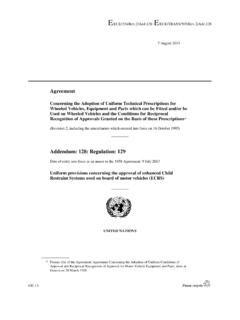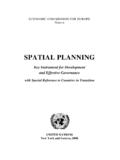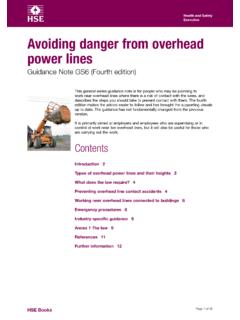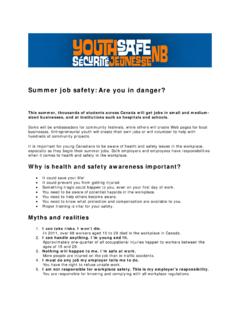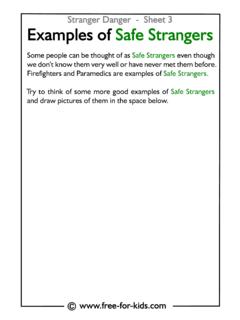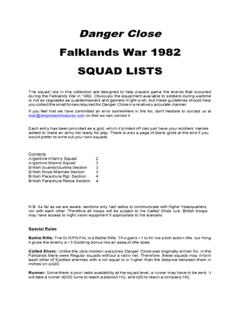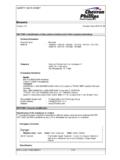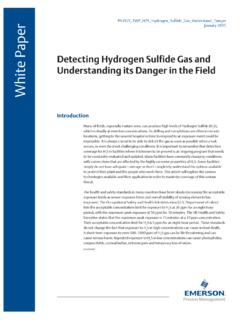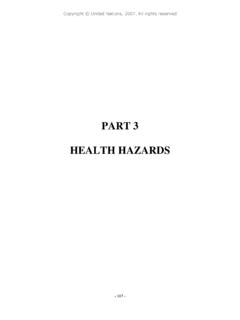Transcription of Recommendations on the TRANSPORT OF DANGEROUS …
1 Recommendations on the TRANSPORT OF DANGEROUS GOODS Model Regulations Volume I Nineteenth revised edition UNITED NATIONSC opyright United Nations, 2015. All rights reserved Copyright United Nations, 2015. All rights reserved ST/ ( ) Recommendations on the TRANSPORT OF DANGEROUS GOODS Model Regulations Volume I Nineteenth revised edition UNITED NATIONS New York and Geneva, 2015 Copyright United Nations, 2015. All rights reserved NOTE The designations employed and the presentation of the material in this publication do not imply the expression of any opinion whatsoever on the part of the Secretariat of the United Nations concerning the legal status of any country, territory, city or area, or of its authorities, or concerning the delimitation of its frontiers or boundaries.
2 ST/ ( ) Copyright United Nations, 2015 All rights reserved. No part of this publication may, for sales purposes, be reproduced, stored in a retrieval system or transmitted in any form or by any means, electronic, electrostatic, magnetic tape, mechanical, photocopying or otherwise, without prior permission in writing from the United Nations. UNITED NATIONS PUBLICATION Sales No. ISBN 978-92-1-139154-1 (complete set of two volumes) e-ISBN 978-92-1-057324-5 ISSN 1014-5753 Volumes I and II not to be sold separately Copyright United Nations, 2015. All rights reserved - iii - FOREWORD The Recommendations on the TRANSPORT of DANGEROUS Goods are addressed to governments and to the international organizations concerned with safety in the TRANSPORT of DANGEROUS goods.
3 The first version, prepared by the United Nations Economic and Social Council's Committee of Experts on the TRANSPORT of DANGEROUS Goods, was published in 1956 (ST/ECA/43- ). In response to developments in technology and the changing needs of users, they have been regularly amended and updated at succeeding sessions of the Committee of Experts pursuant to Resolution 645 G (XXIII) of 26 April 1957 of the Economic and Social Council and subsequent resolutions. At its nineteenth session (2-10 December 1996), the Committee adopted a first version of the Model Regulations on the TRANSPORT of DANGEROUS Goods , which were annexed to the tenth revised edition of the Recommendations on the TRANSPORT of DANGEROUS Goods.
4 This was done to facilitate the direct integration of the Model Regulations into all modal, national and international regulations and thereby enhance harmonization, facilitate regular updating of all legal instruments concerned, and result in overall considerable resource savings for the Governments of the Member States, the United Nations, the specialized agencies and other international organizations. By resolution 1999/65 of 26 October 1999, the Economic and Social Council extended the mandate of the Committee to the global harmonization of the various systems of classification and labelling of chemicals which are applicable under various regulatory regimes, : TRANSPORT ; workplace safety; consumer protection; environment protection, etc.
5 The Committee was reconfigured and renamed Committee of Experts on the TRANSPORT of DANGEROUS Goods and on the Globally Harmonized System of Classification and Labelling of Chemicals , supported with one sub-committee specialized in TRANSPORT of DANGEROUS goods and another one addressing the global harmonization of classification and labelling of chemicals. At its seventh session (12 December 2014), the Committee adopted a set of amendments to the Model Regulations on the TRANSPORT of DANGEROUS Goods, concerning, inter alia,the TRANSPORT of viscous liquids; gases; polymerizing substances; internal combustion engines or machinery powered by flammable liquids or gases; electric vehicles; lithium batteries and ammonia dispensing systems.
6 This nineteenth revised edition of the Recommendations takes account of all the amendments which were circulated as documents ST/ At its seventh session, the Committee also adopted amendments to the Recommendations on the TRANSPORT of DANGEROUS Goods, Manual of Tests and Criteria (ST/ ), which will be reflected in sixth revised edition of the Manual (ST/ ), as well as amendments to the Globally Harmonized System of Classification and Labelling of Chemicals (GHS) (ST/ ), which will be reflected in the sixth revised edition of the GHS to be published as document ST/ Copyright United Nations, 2015. All rights reserved - iv - This publication has been prepared by the secretariat of the United Nations Economic Commission for Europe (UNECE) which provides secretariat services to the Economic and Social Council's Committee of Experts.
7 Additional information, including corrigenda to this publication, if any, may be found on the UNECE TRANSPORT Division website: Copyright United Nations, 2015. All rights reserved- v - CONTENTS VOLUME I Page Recommendations ON THE TRANSPORT OF DANGEROUS GOODS .. 1 Nature, purpose and significance of the Recommendations .. 1 Principles underlying the regulation of the TRANSPORT of DANGEROUS goods .. 1 Classification and definitions of classes of DANGEROUS goods .. 2 Consignment procedures .. 2 Emergency response .. 3 Compliance assurance .. 3 TRANSPORT of radioactive material .. 3 Reporting of accidents and 3 Figure 1: Data sheet to be submitted to the United Nations for new or amended classification of substances.
8 4 ANNEX: MODEL REGULATIONS ON THE TRANSPORT OF DANGEROUS GOODS .. 9 Table of contents .. 13 Part 1: General provisions, definitions, training and security .. 19 Part 2: Classification .. 49 Part 3: DANGEROUS Goods List, special provisions and exceptions .. 179 APPENDICES .. 343 Appendix A: List of generic and proper shipping names .. 345 Appendix B: Glossary of terms .. 365 ALPHABETICAL INDEX OF SUBSTANCES AND ARTICLES .. 377 Copyright United Nations, 2015. All rights reservedCONTENTS (cont'd) - vi - VOLUME II ANNEX: MODEL REGULATIONS ON THE TRANSPORT OF DANGEROUS GOODS .. 1 (cont'd) Part 4: Packing and tank provisions .. 3 Part 5: Consignment procedures.
9 143 Part 6: Requirements for the construction and testing of packagings, intermediate bulk containers (IBCs), large packagings, portable tanks, multiple-element gas containers (MEGCs) and bulk containers .. 185 Part 7: Provisions concerning TRANSPORT operations .. 375 TABLE OF CORRESPONDENCE between paragraph numbers in the IAEA Regulations for the Safe TRANSPORT of Radioactive material (2012 Edition), and the nineteenth revised edition of the Recommendations on the TRANSPORT of DANGEROUS Goods (including the Model Regulations) .. 393 Copyright United Nations, 2015. All rights reserved - 1 - Recommendations ON THE TRANSPORT OF DANGEROUS GOODS NATURE, PURPOSE AND SIGNIFICANCE OF THE Recommendations 1.
10 These Recommendations have been developed by the United Nations Economic and Social Council's Committee of Experts on the TRANSPORT of DANGEROUS Goods1 in the light of technical progress, the advent of new substances and materials, the exigencies of modern TRANSPORT systems and, above all, the requirement to ensure the safety of people, property and the environment. They are addressed to governments and international organizations concerned with the regulation of the TRANSPORT of DANGEROUS goods. They do not apply to the bulk TRANSPORT of DANGEROUS goods in sea-going or inland navigation bulk carriers or tank-vessels, which is subject to special international or national regulations.
